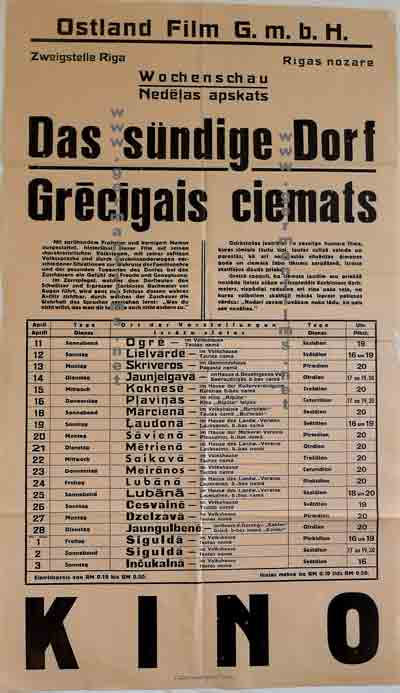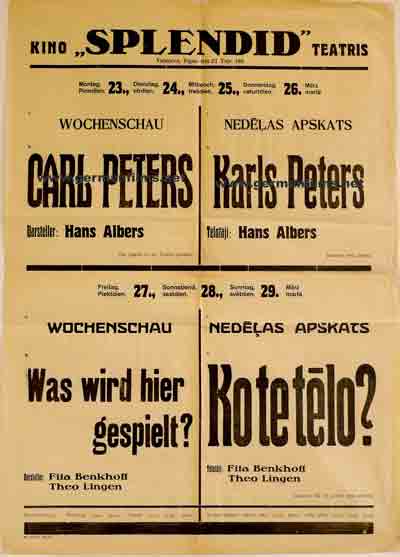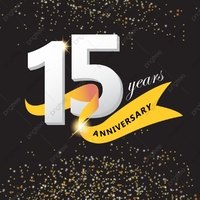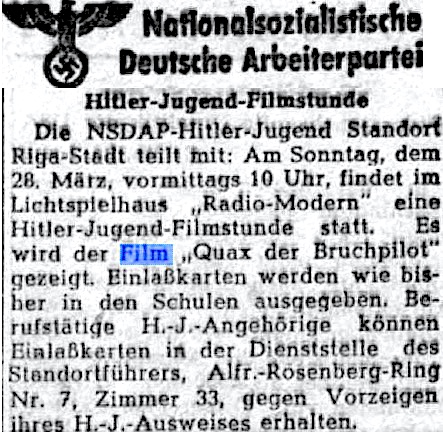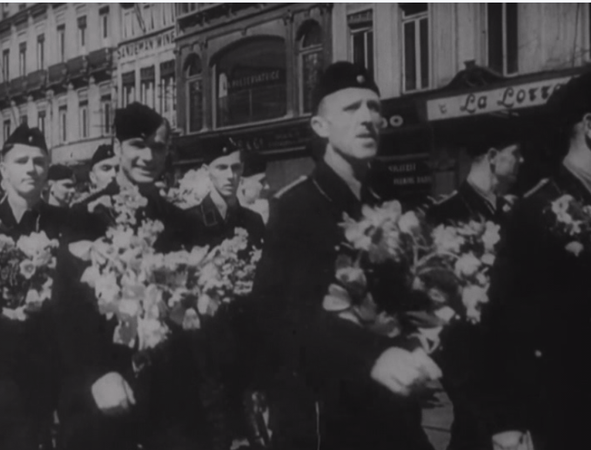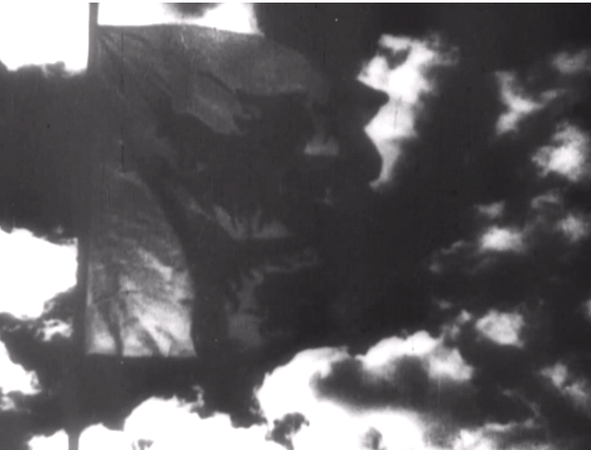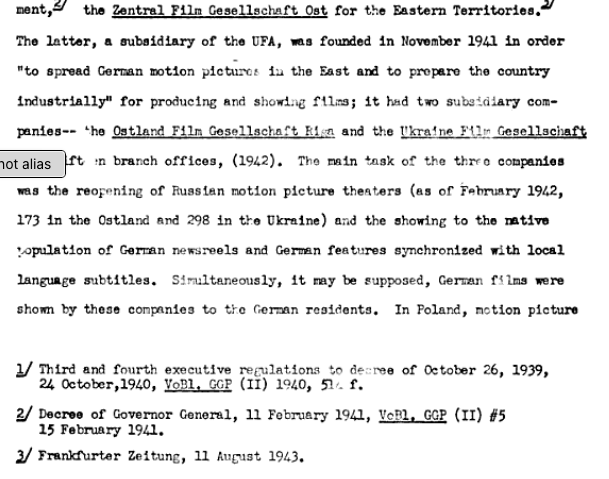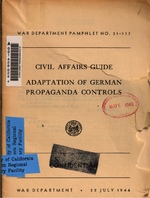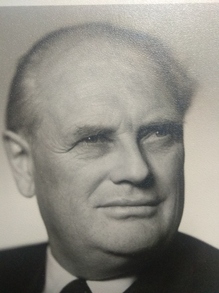The Z.F.O. and it's subsidiary film production
companies operating in the Occupied USSR.

" The Zentralfilmgesellschaft Ost mbH was a German film production company based in Berlin. It was founded after the German invasion of the USSR on November 10, 1941, in order to make the film studios and cinemas in the occupied territories usable for the purposes of German film propaganda. The stolen production facilities in Riga, Reval and Kiev were transferred to subsidiaries: Ostland-Film-Gesellschaft mbH was established in Riga and Ukraine-Film-Gesellschaft mbH in Kiev. These companies set up traveling cinemas, opened fixed cinemas and repaired damaged cinemas. Among other things, they ensured that each time a ghetto was liquidated, i.e. the evacuation of the residents to extermination camps, among which the anti-Semitic mood among the non-Jewish population was fueled by the screening of the film Jud Süß. The Zentralfilmgesellschaft Ost also produced a number of its own films. " [ Note: this paragraph was translated from the German Wikipedia entry.]
In regard to the screening of Jud Süß in the Eastern Territories, a magazine article in Der Deutsche Film (Heft 4, Jhrg. 7 – October 1942) stated:
In fact, the subject of a film outside [of Germany] doesn't play the same role as at home; serious and cheerful films, entertaining and problematic are followed with the same interest. Only the feelings, thoughts and reactions of the soldiers to a film are sometimes different than at home.
It makes a big difference whether you watch the film "Jud Süß" in your home country or experience it in a city where more than three quarters of the inhabitants are Jews.

Accompanying the article "Film at the Front" was the above photograph showing a mobile cinema vehicle being pulled by a tractor on a muddy Soviet 'road.' RPL refers to the Reichspropagandaleitung, or Reich Propaganda Leadership office, which coordinated all such propaganda film efforts across the Reich and all wartime territories of the Reich. The RPL was a branch of the NSDAP formally, but of course acted as an arm of government.
The ZFO initially operated out of the Ufa offices in Central Berlin but by 1943 had been re-located to Rungestrasse 25 in the Friedrichshain area. The building still stands – this photo was taken in April 2022 for us:
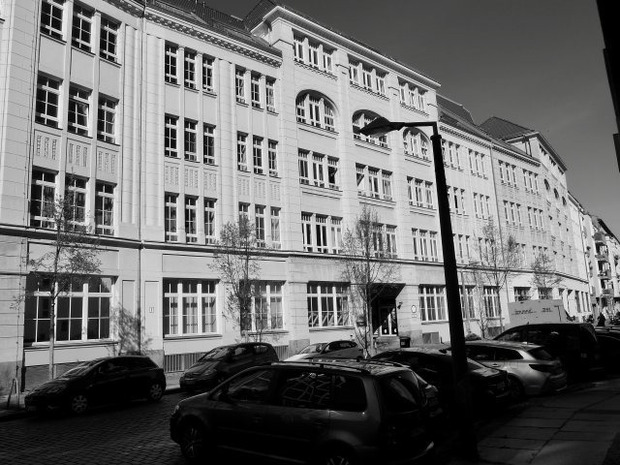
The Board of Directors of the ZFO represented a variety of men chosen to bring expertise from various leading film and propaganda agencies to bear on their anti-Soviet propaganda film mission:
ZFO Board of Directors
Dr. Jud. Erich Müller–Beckedorff, Chairman, Tobis Filmkunst
SS-Brigadeführer Friedrich Zimmermann, Reich Ministry for the Occupied Eastern Territories
Dr. Eberhard Taubert, Ministry of Propaganda (Cheif, secret anti-Soviet Office "Vineta,", Scriptwriter, Der ewige Jude.)
Dr. Günther Schwarz, Reichsfilmkammer
Dr. Karl Ott, Reich Finance Ministry (Advisor, Wien-Film)
Hermann Burmeister, Reich Finance Ministry
Gustav Schlotterer, Reich Ministry of the Economy
Dr. Georg Leibbrandt, Reich Ministry for the Occupied Eastern Territories [attended Wannsee Conference, January 20, 1942].
A biographical sketch of Dr. Müller–Beckedorff can be found by scrolling down this web page.
FOR MUCH MORE BACKGROUND HISTORY ON THE "ZFO" ----
There are three main sources for information and the history of the ZFO and its satellite film production companies in the Occupied Eastern Territories of Nazi Germany.
1. The seminal Chapter 24 written by Dr. Ralf Forster in the 2nd edition (not in the 1st edition!) of the book Cinema and the Swastika, Editors Roel vande Winkel and David Welch; Palgrave, 2011, London.).
2. The original German language version of the same Chapter by Dr. Forster in the book Träume in Trümmern, CineGraph, 2009 München. In the same book, the excellent Chapter on Ukraine–Film-GmbH by Hans-Joachim Schlegel.
3. The Russian website Antique Photos, which has a very comprehensive history of the Ukraine film production 1941-1944; available in both Russian and English; which is pro–Soviet in its historical perspective. The web page includes the story of what happened to Soviet citizens who had collaborated with and worked for the ZFO after they were arrested by the GPU upon Germany's defeat. Found here:
http://antique-photos.com/en/component/content/article/164-collectorhelp-en/848-film-distribution-production-in-occupied-ukraine-1941-1944.html .
It is not the intention of this web page to re-tell the entire history of the ZFO, which we leave to the above main research sources, but to provide some context for visitors wishing to see what ZFO, Ostland Film, Ukraine Film and Riga Film original materials and posters we have in our Collection. We recommend that readers avail themselves of the three main sources above.
The ZFO's role in Nazi film production is reflected in this German Film Organisational Chart ---from Spiker, FILM UND KAPITAL – Zur politische Ökonomie des NS.-Films.
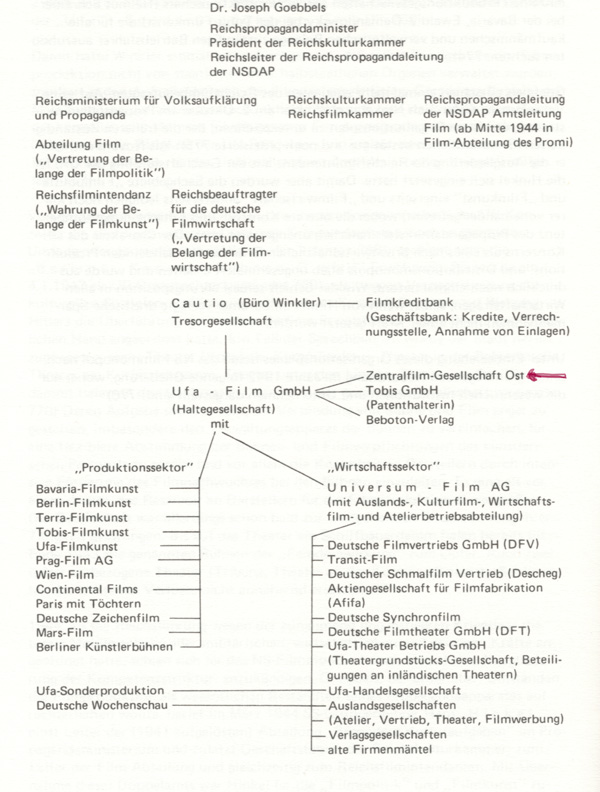
In the reference book Il Cinema Tedesco, published in Roma, 1942, the organisational chart above was provided to Fascist readers in Italian. The ZFO is circled in red:
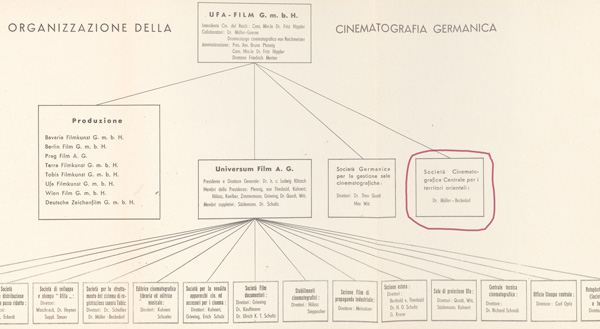
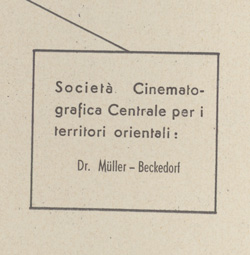
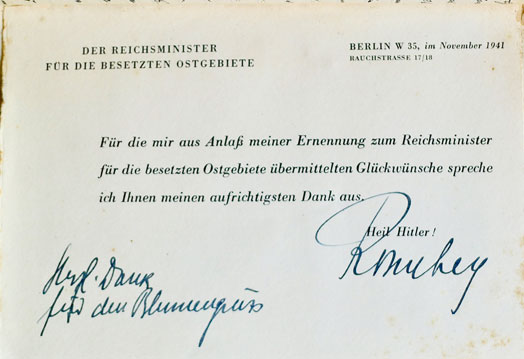
Ostland Film GmbH and sister film companies in the Occupied Eastern Territories 1941–1944.
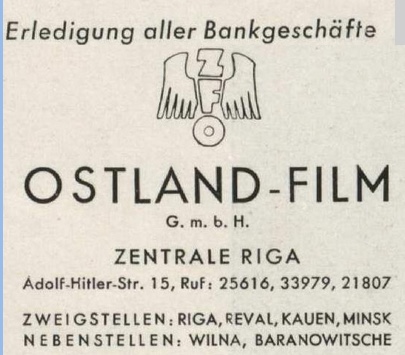
BELOW: Three envelopes from 1941–1944 with FILMBETRIEBE OSTLAND's return address of Adolf-Hitler–Straße 15, Riga and from RIGA FILM GmbH. FURTHER BELOW, a view of that street at the time, in daytime and BELOW, on a rainy night. All materials shown are from our Collection.
This first envelope is addressed to the ZFO Headquarters in Berlin, from the Riga Ostland-Film offices, and the post mark is cancelled with the date 15 September 1944 --- just weeks before the Red Army re–conquered Riga and German troops withdrew forever.
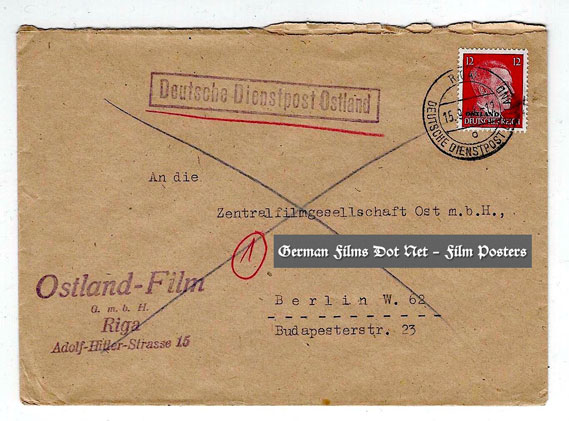

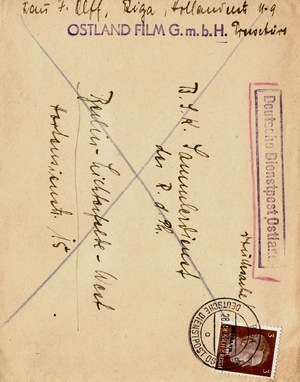
A fourth letter envelope. this one for sister firm UKRAINE FILM GmbH
from the Capitol cinema in Kostopol, Ukraine.
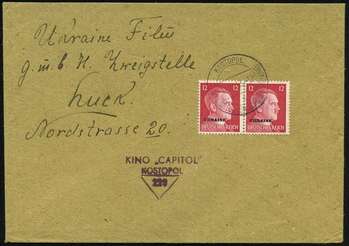
BELOW: A wartime look at Adolf Hitler Straße, Riga with the building which housed the Ostland Film GmbH HQ at the time, (Left), a 2017 photo of the building, which survived the war and is now where the Embassy of the Kingdom of Norway is located, taken by German Films Dot Net (Right), and a wartime postcard of the Adolf Hitler Straße taken on a rainy night in Riga.
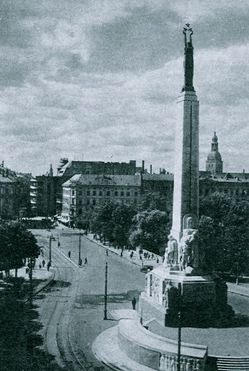
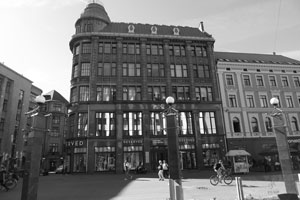
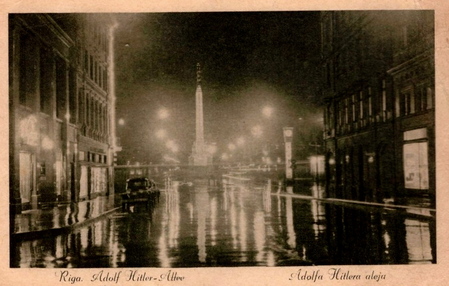
A contemporary Wehrmacht street map showing Adolf-Hitler–Str. as the main avenue.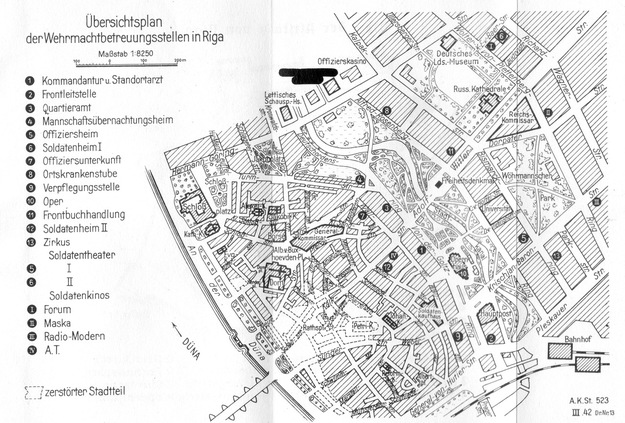
Other Reichskommissariat Ostland propaganda activity had offices at Adolf-Hitler-Strasse 15 as well. One of these was that of "Sendergruppe Ostland" -- the radio network which published a weekly broadcasting program guide. This one was for the week of 9 to 15 November 1941:
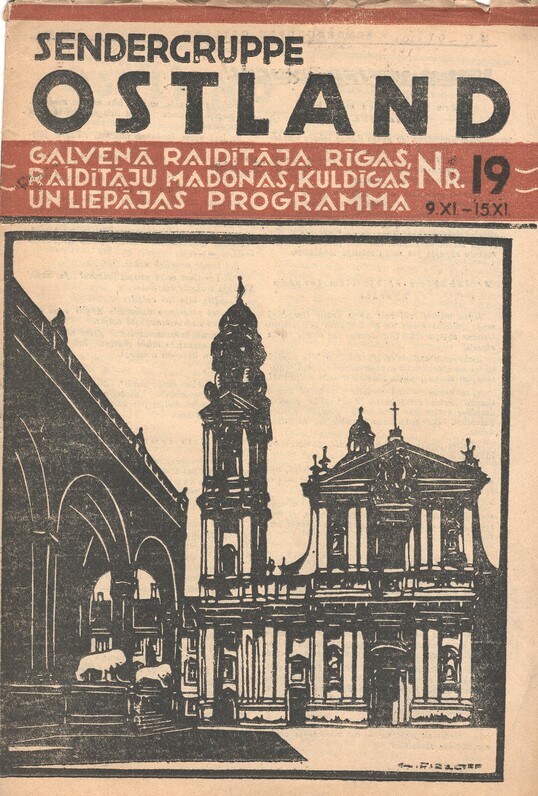
Today, the Riga Film Museum has a display about the Riga Film GmbH production company during the German Occupation in WWII. We highly recommend a visit to this very interesting and important Baltic film museum:
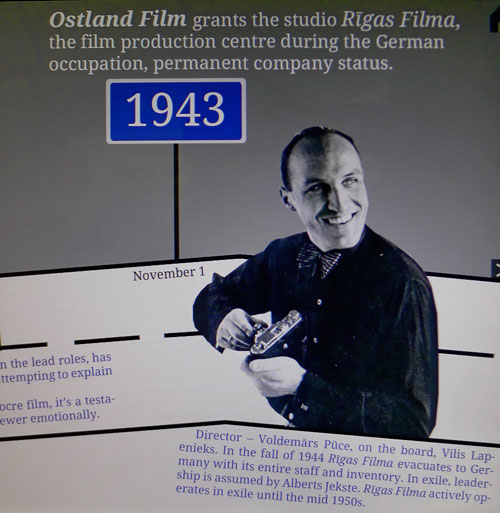
An Ostland–Film G.m.b.H. full–page advertisement in the September 1942 issue (#3) of the Ostland – Monatschrift des Reichkommissars für das Ostland, published in Riga.
The German soldiers' cinema in Riga (below).
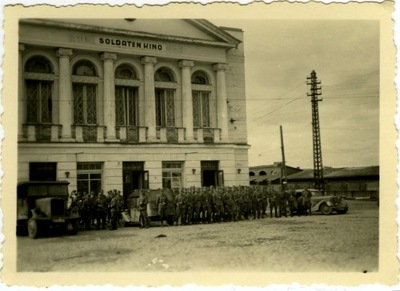
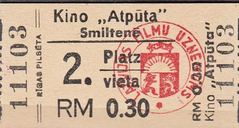

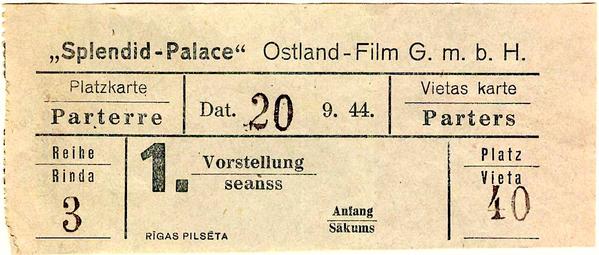
More photographs and information on the "Splendid-Palast" cinema in Riga, and the actual super–rare original poster for a German propaganda film being screened there in 1943 can be found here. The cinema survived both WWII and Soviet Occupation and is one of Riga's cherished Art Noveau Rococo style architectural gems. The building was opened in 1923.
The German newspaper Deutsche Zeitung im Ostland, published in wartime Riga, in its 23 December 1943 issue, advertised no fewer than sixteen (!) German feature films showing across greater Riga that day, including the Agfacolor smash hit MÜNCHHAUSEN, amongst others. Note the advertisement for Ostland Film GmbH in the panel under the daily movie screening schedule, promoting it's propaganda short films.
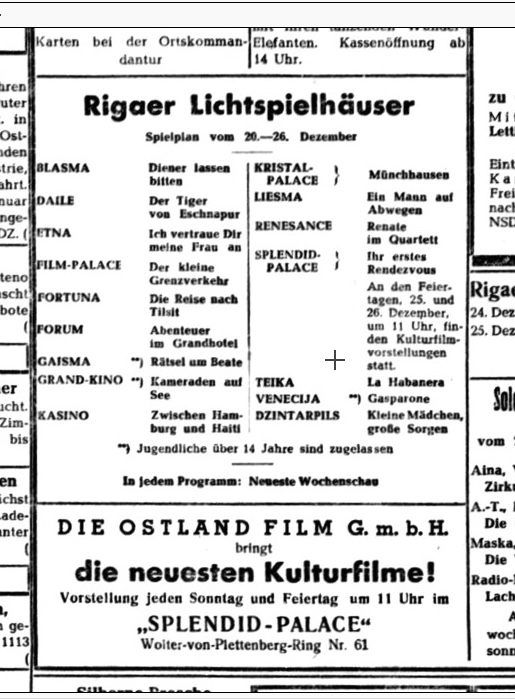
Below, the hugely popular Gustav Ucicky film Der Postmeister starring Hilde Krahl and Heinrich George being advertised in Kiev, capital of the Occupied Ukraine. Photo courtesy of the Film–Kurier Tageszeitung #272, 19 November 1942. Hilde Krahl's image is the same one used on our German poster of the film.
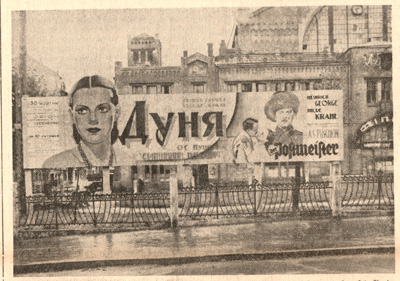

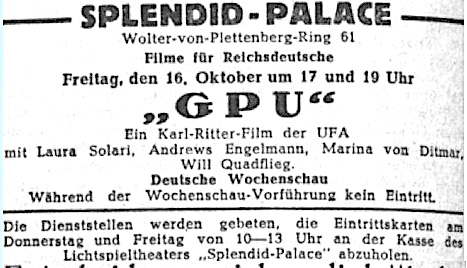
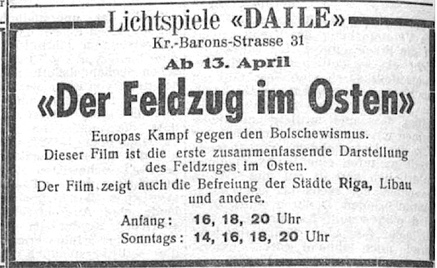
Ostland Film G.m.b.H; Riga
During the campaign against the Soviet Union, propaganda film entities overseen by the Ministry of Propaganda and Alfred Rosenberg's Ministry of the Eastern Occupied Territories in Berlin were established under the control of "Zentralfilmgesellschaft Ost" (ZFO). ZFO was founded on 10 November 1941 and the Ufa film studio oversaw film production. Later in the war, well after the tide turned, in October 1944, Tobis Filmkunst assumed management of the film companies.
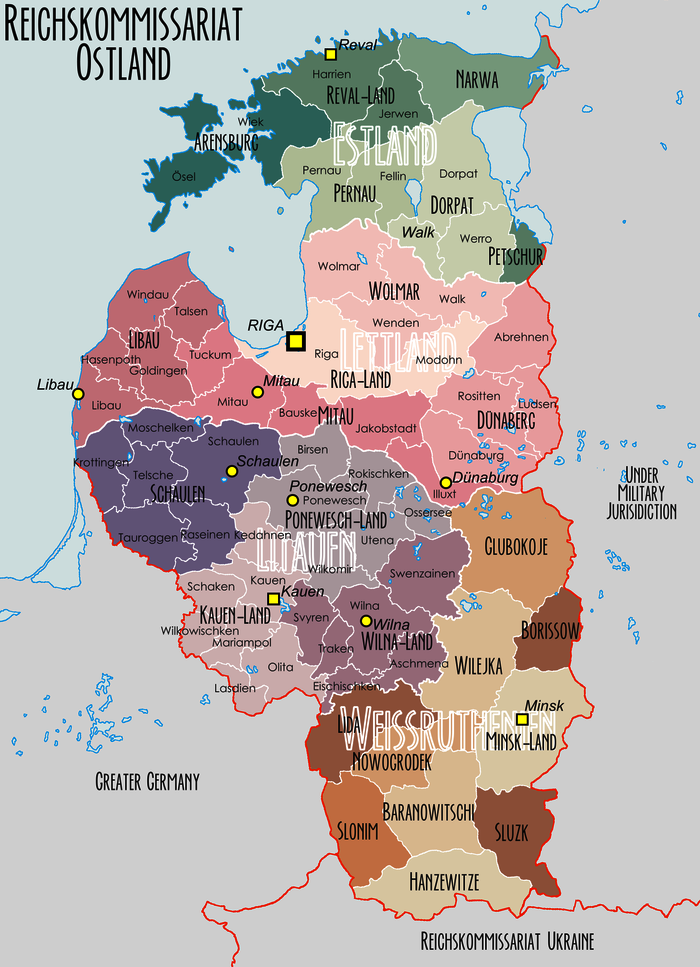
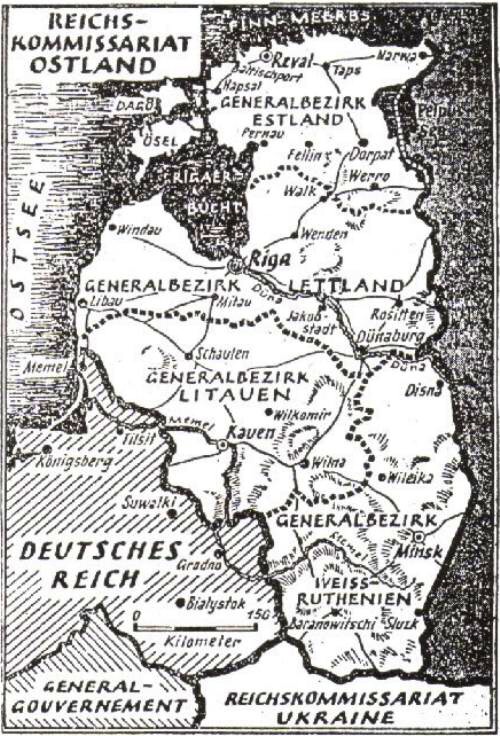
The Ukraine in 1943 as depicted in the Das kleine Ukraine Buch (Berlin, 1943):
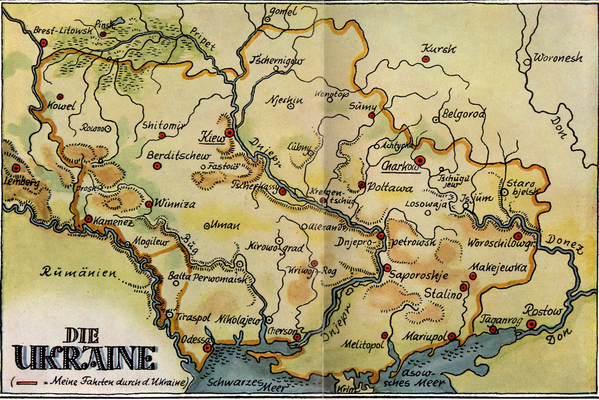

ABOVE: On the occasion of his 50th birthday, Reichsminister für die Besetzten Ostgebiet, Alfred Rosenberg, is greeted by his two Reichskommissars, Hinrich Lohse (Ostland) and Erich Koch (Ukraine) at the Ostministerium HQ at Unter den Linden 63, on 12 January 1943. [private album photo from our ZFO/Ostland Film archive.]


LEFT: Hinrich Lohse, appointed as Reich Commissar of the Ostland on 8 December 1941. He thus oversaw the administration of the Baltic States of Estonia, Lithuania, and Latvia until the end of the German occupation in WWII. He had heretofore been the Gauleiter of the Provence of Schleswig–Holstein since 1935.
Eventually, five companies were established: Riga-Film (film production) and two 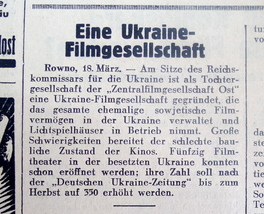 film distribution entities: Ostlandfilm GmbH (also written as Ostland Film GmbH in places) in Riga, and Ukraine–Film GmbH in Kiev, as well as Deutsche Kaukasus–Film GmbH and "Elbrus" Film–Arbeitsgemeinschaft GmbH. The latter two companies apparently never actually produced any films and were dissolved by mid–1942 due to military reversals on the Eastern Front. Author Babette Quinkert, in her book Propaganda und Terror in Weißrussland 1941–1945 (Ferdinand Schönlingh Verlag, Padeborn, 2009) states that Ostland Film GmbH in 1942 employed 1,400 locals with 25 Germans supervising them in film production. (Ukraine Filmgesellschaft clipping from the Film–Kurier Tageszeitung, #67, 20 März 1942.)
film distribution entities: Ostlandfilm GmbH (also written as Ostland Film GmbH in places) in Riga, and Ukraine–Film GmbH in Kiev, as well as Deutsche Kaukasus–Film GmbH and "Elbrus" Film–Arbeitsgemeinschaft GmbH. The latter two companies apparently never actually produced any films and were dissolved by mid–1942 due to military reversals on the Eastern Front. Author Babette Quinkert, in her book Propaganda und Terror in Weißrussland 1941–1945 (Ferdinand Schönlingh Verlag, Padeborn, 2009) states that Ostland Film GmbH in 1942 employed 1,400 locals with 25 Germans supervising them in film production. (Ukraine Filmgesellschaft clipping from the Film–Kurier Tageszeitung, #67, 20 März 1942.)
Ostland Film GmbH was managing the cinemas, film distribution, and propaganda film production in the Reichskommissariat Ostland, and the Ukraine Film GmbH was managing the cinemas and film distribution and propaganda film production in the Reichskommissirat Ukraine.
BELOW: A German Press Agency photograph of two dozen mobile cinema trucks (Tonfilmwagen) in a staging area in Cracow, Poland on 2 February 1942, including portable electricity generators, and their drivers and crews, ready to depart for the Eastern Front. These trucks brought movies to rural populations in the Occupied USSR, Ukraine, and the Battic States who had no access to metropolitan cinemas. The ZFO worked such Tonfilmwagen in these war zones similarly to the Gaufilmstelle mobile cinema trucks in the Greater German Reich and Böhmen & Mähren.
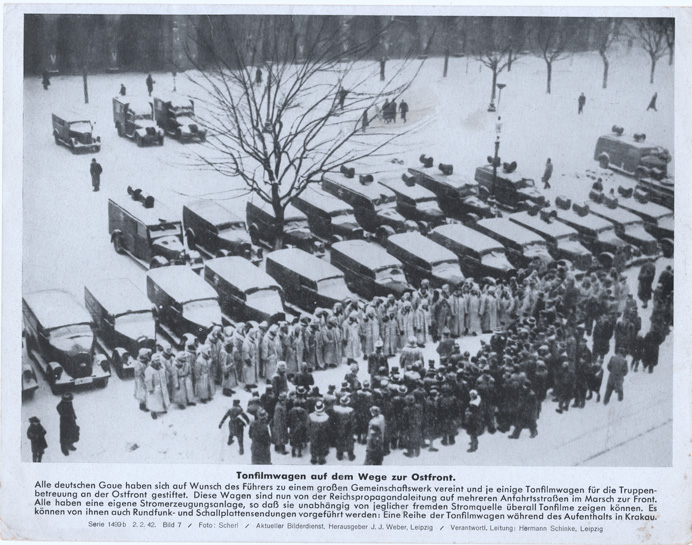
Note the " Z F O " logo in the middle of the Ukraine Film GmbH rubber stamp on the envelope below on the LEFT; making up part of the Russian imperial eagle styled graphic design.....which was also used at the beginning of the propaganda films as the film studio logo, below RIGHT:
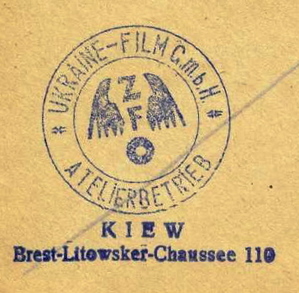
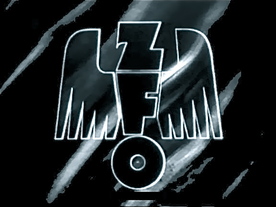
The Ostland Film GmbH also developed its own logo, which can be seen here as the opening credit on its Latvian language version of Roter Nebel :
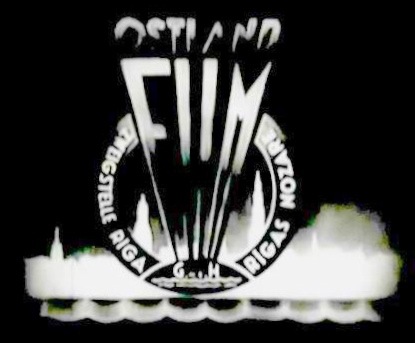
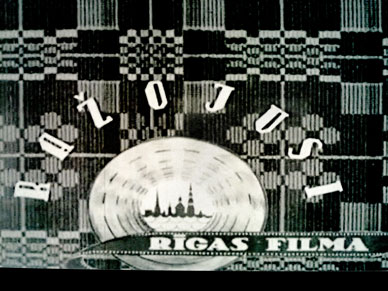
The 5 September 1942 film newspaper Film Kurier Tageszeitung reported that Ukraine Film gmbH had branches in Kiev, Dnepropetrowsk, Nikolajew, Shitomir, Tschernigow, and in Melitopol in the Crimea. On 30 November 1942 the same film newspaper reported that Ukraine Film GmbH also had branch offices in Luzk, Saporoskje, Kirwoj Rog, Kirowograd, Potawa, Winniza and Prokurow. Ostlandfilm GmbH also had branches in Reval, Kaunas , Wilna, Dorport, and Minsk. The Deutsche Wochenschau GmbH also had a subsidiary in Riga. Note that Ostlandfilm is spelled Ostland Film on one of the posters below. As of 31 August, 1943, the ZFO had 121 employees, Ukraine–Film had 141 employees, and Ostland Film had 33 employees. At the beginning of 1944, the ZFO set up a dubbing lab in Paris for the films produced for the East. In October 1944 due to the German retreat, the ZFO was put under the aegis of Tobis Filmkunst in Berlin.

The main function of these motion picture distribution companies was to 'enlighten, ie: make Bolshevism impossible as a doctrine and make it out to be responsible for the lowly position of the peoples of the East because of its war industries,‘ to 'entertain, in order to maintain and heighten pleasure in working,', to 'intimidate, in order to limit unrest to a minimum, and to bring Germany's industrial and military predominance to peoples' attention in an ever more awe-inspiring way,' and finally, to 'prevent individual ethnic groups from having autonomy in the area of culture or suchlike, and therefore from wanting freedom to administer their own affairs.' (Vande Winkel, Roel & Welch David, Editors; Cinema & The Swastika, 2nd edition 2011, palgrave, p.120, from Chapter 24, by Ralf Forster, German Film Politics in the Occupied Eastern Territories 1941–1945. )
Auf Deutsch finden Sie alles unter: ‘ Deutsche Filmpropaganda im “Ostraum” – Die Zentral - Filmgesellschaft Ost (ZFO) 1941-1945,‘ Ralf Forster, Kapitel 4, S.46–64; Träume in Trümmern, CineGraph, 2009 München.)
In a review of its full year of operations, the Film Kurier Tageszeitung on 9 January 1943 reported that Ostland Film GmbH, which oversaw some 175 cinemas presented to a reported 19 million audience members in 1942/43 such German productions as the Veit Harlan Agfacolor film Die goldene Stadt, Steinhoff's Rembrandt, Carl Peters, Andreas Schlüter, Dr.Crippen an Bord, Zarah Leander in Die große Liebe, Fronttheater, Wiener Blut, U-Boote-Westwärts, Nacht in Venedig, and Wiener Blut.
On the front page of the Film–Kurier Tageszeitung of 3 May 1943, the ZFO announced that in addition to distributing German films with Estonian, Lithuanian, Byelorussian, and Ukrainian subtitles, in future the Deutsche Wochenschau newsreels would be screened in both Russian and Ukrainian dubbed versions.
In the book Das kleine Ukraine Buch, (Fritz Wimschneider, F.Bruckmann Verlag, München, n.d.) it is stated:
" The Ukraine Film Company ZFO has taken over the huge Kiev studios and the effort is so far expanded that in their own film copying laboratory German films can be subtitled in Ukrainian, and already the production of cultural films could be tackled. The ZFO today supplies the entire occupied territory with movies, in charge of the theaters and has already won the German films millions of friends." Although the book has no publication date, the book's Introduction is dated 'Herbst 1943.'
In the 24 May 1943 issue of Film–Kurier Tageszeitung, it was reported that Ukraine Film GmbH had produced a series of documentary films for the local populations, such as the farmer and worker film Wir schaffen in Deutschland (shown below) , as well as Der Weg ins Reich, and Brief in die Heimat, about the life of foreign workers living in the Reich. A film entitled Mit eigenen Augen (With their own eyes) showed the impressions of Russian workers and farmers on a tour of Germany. A cultural film Der Spiegel der Zeit told of the support for an illustrated newspaper in a community. Two cultural films being planned were Das schöne Ostland and Am Land der schwarzen Erde. Other films to be produced included two on the return of russian farmers from Soviet imprisonment, Der Rückkehrer and Das neue Leben. A further cultural film was to show the city of Kiev destroyed by the Soviets and being rebuilt by the Germans.
Regarding the above–mentioned film Der Rückkehrer, we have in our Collection ZFO correspondence of the stills photographer Herbert Jacobi and we show BELOW the ZFO travel orders correspondence which states that Jacobi is responsible for the safe transport of film material, film negatives and requisitions from Frankfurt/Oder to Berlin which are important to the war effort associated with the anti–Soviet propaganda feature film Der Rückkehrer under contract from the Ministry of Propaganda (i.e. Dr. Goebbels.) Incidentally, the Berlin address of the ZFO offices rubber–stamped at the end of this memorandum survived the war and was converted to apartments in the 1990's.
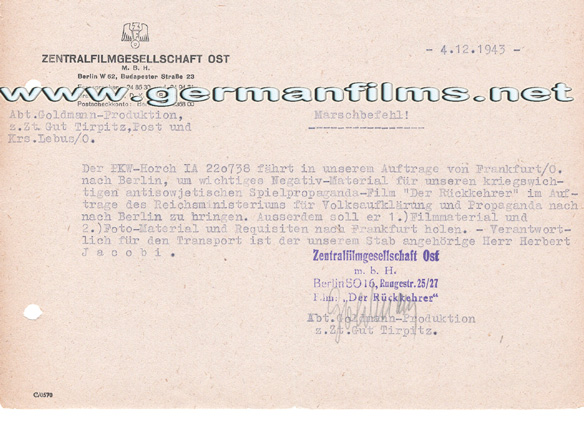
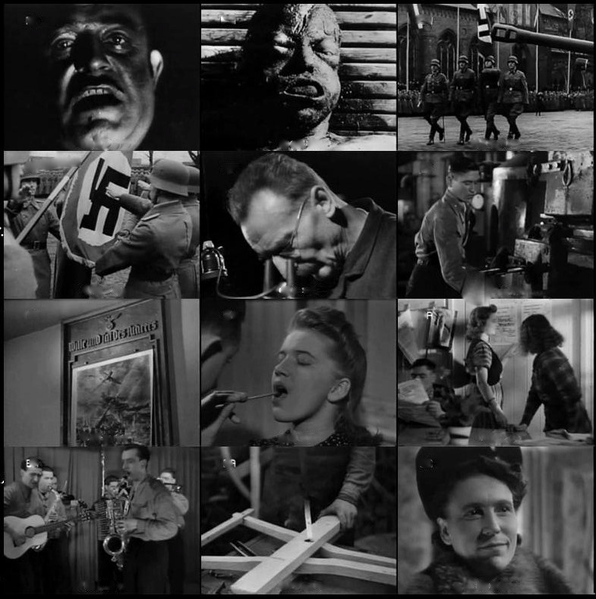
[ ABOVE: Scenes from Wir schaffen in Deutschland, ZFO / Ukraine Film GmbH co–production, 1942, Director: Goldmann. The film was about Eastern workers volunteering to work in Germany, and included anti-Bolschevik footage from the ZFO / Riga Film GmbH sister production, Roter Nebel /Red Mist, also 1942. The Collection has copies of the four films Wir fahren nach Deutschland, Wir leben in Deutschland, Wir schaffen in Deutschland, Der Führer und sein Volk, as well as Roter Nebel. We cannot make copies of these films available, it must be noted. ]
Two film frames: (1) The opening title card for Roter Nebel (Red Mist), the anti–Communist film produced by ZFO in many languages, and distributed across territories liberated from the Soviet Union in the period 1941-1944. (2) The famous scene of a German soldier crushing the Red Star cap with his boot at the end of the film.


BELOW : Roter Nebel advertised in the schedule of the Daile Cinema and in the Splendid–Palace Cinema, Riga in June 1943, along with another Ostland Film called Schweinpech/Bad Luck, about black market trafficking:
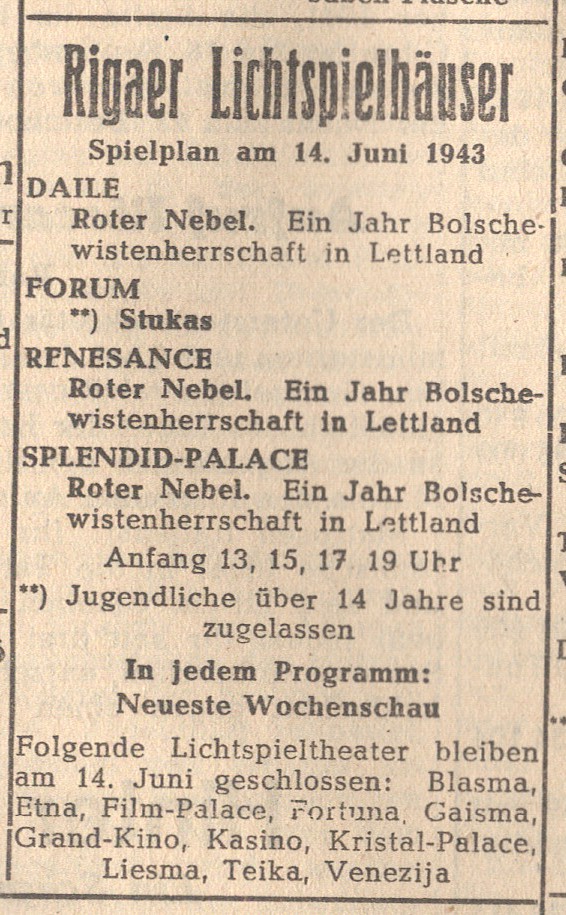
The 24 February 1945 (!) announcement that Roter Nebel was approved for distribution inside the Geman Reich. This notice appeared in that day's Film-Nachrichten weekly film newspaper in Berlin. From our Collection.
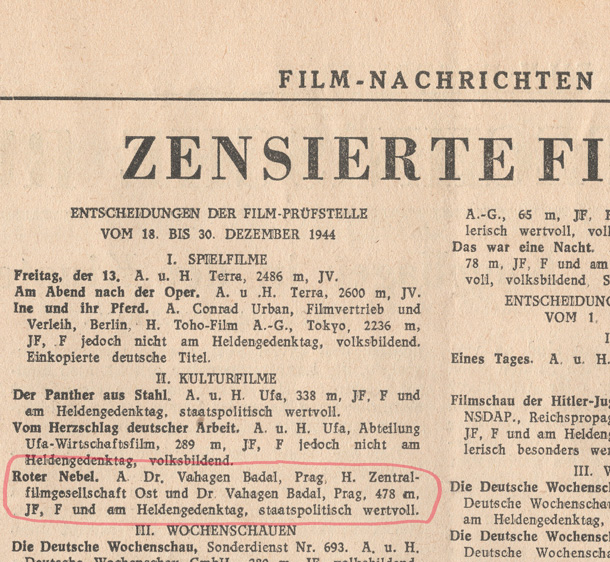
In our ZFO/Ostlandfilm library are:
–Wir fahren nach Deutschland (1942)
–Wir schaffen in Deutschland (1943)
– Wir leben in Deutschland (1943)
– Der Führer und sein Volk (1941/1942)
–Roter Nebel (1942, the Latvian version, also the Latvian version with German soundtrack, ands the Flemish language version)
– Kossaken (1943, Ostlandfilm fragment)
- Deine Hände (1942/43)- 17 min. Latvian version
- Teilnahme des Lettischen Volkes im Grossen Kampf gegen den Bolschewismus (1942)– 18 min.
- Fahrschule des Zentralverbandes der Berufverbaende beim Generalkommissar in Riga (1942)- 13 min.
– Roter Nebel (1942) - 18 min.
– Arbeiterinnen in Riga (1942) - 7 min.
– five Ostland Woche newsreels (1942, 1944)
– and a Latvian Luftwaffenhelfer short from 1944.
–Schweinpech / Bad Luck (1942) - ca. 13 min.
– Wir antworten Moskau! – 10 minutes.. Latvian. Note this film is listed in the ZFO Filmographie found in CineGraph's monograph Träume in Trummern: Film-Produktion und Propaganda 1940–1950 as "Feststellen unsicher," meaning "documentation uncertain." The film does indeed exist as a completed film in 1943/44. The film is an explicit refutation of the goals of the Allied "Moscow Conference" held between 18 October and 11 November 1943, so the film must have been produced thereafter.
– Wir gehen in der Garten (1943). A film about instruction about agriculture, gardening, food production, irrigation,etc. –32 minutes. This fim is not listed in the ZFO Filmographie.
– Riga Ballet (1942/43) – 20 minutes. Silent footage from this Woldemar Putze documentary filmed in the Riga State Opera House in mid–1942.
BELOW, are some scenes from the Teilnahme des Lettischen Volkes im Grossen Kampf gegen den Bolschewismus (1942)......
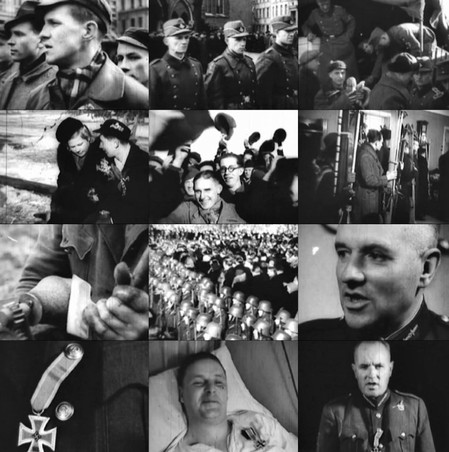
BELOW, are some screenshots from the Flemish version of ROTER NEBEL. It is the first proof we have collected that the distribution of nation–specific language versions of the film were planned in non-Russian, non-Baltic versions. The Flemish version uses about twelve minutes of the film's anti-Bolshevik footage and narrative about the nefarious Communist takeovers in the Baltic States pre-1941, the horrors of the Red occupation,but then a tirle card shouts "Our homeland is in danger too!" and the final three minutes of this version seque into showing cultural landmarks, castles, heritage sites, and marching Flemish Waffen– SS and new volunteers in the fight against Bolshevism. Such films were planned in more than a dozen versions including French and English. There are no other versions extant of these national versions which have surfaced to date m to our knowledge. (December 2023).
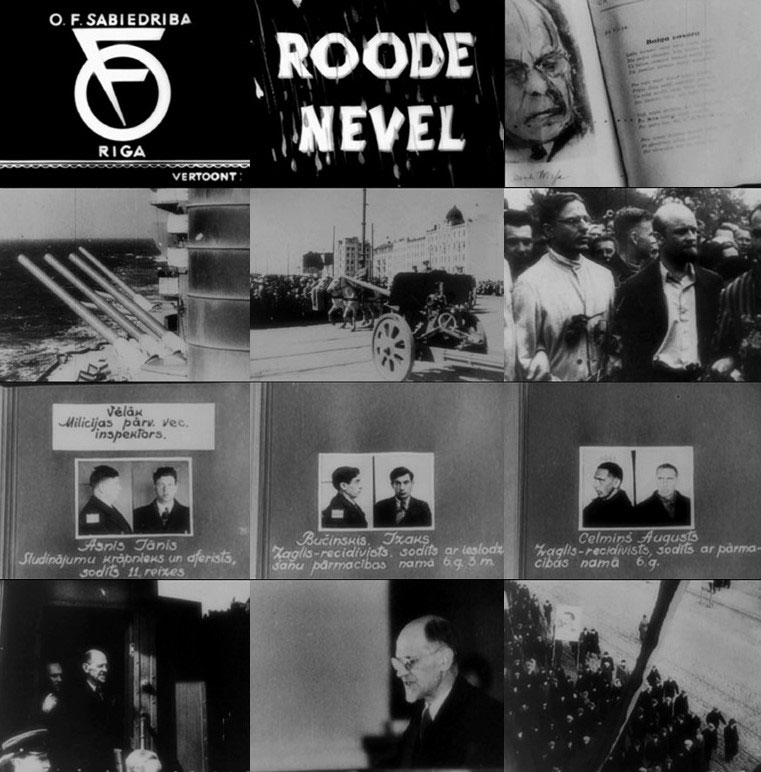
Here are screenshots of Flemish-specific scenes which bring the film to a rousing conclusion:

Scholars! We have during our research discovered an Ostland Film title which is not mentioned in either of the two reference books cited at the beginning of this page. It does not exist in the ZFO Filmography either as a completed film or one planned but not produced before the German evacuation. That film is described here, in an article in the Deutsche Zeitung im Osten newspaper of 28 Mai 1943:
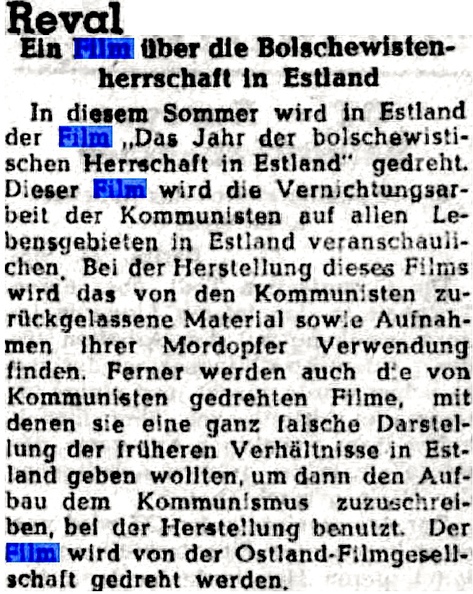
Film historian Hans–Joachim Schlegel, on page 70 in his Chapter "Ukraine-Filmgesellschaft MBH" in the CineGraph book TRÄUME IN TRÜMMERN –Film-Produktion und Propaganda 1940–1950 (et+k, 2009) cites a German Federal Archive file which reported that the most popular German film screening in the Ukraine as at 31 March 1943 was Gustav Ucicky's Der Postmeister, and that the second–most popular film was Harlan's Jud Süß. The 5 August 1943 issue of the Film Kurier Tageszeitung reported that the five most popular German feature films in the Ostland were Operette, Die große Liebe, Quax der Bruchpilot, Jud Süß, and Ich klage an. The five most popular films in Ukraine were Kora Terry, Operette, Stern von Rio, Opernball and Der Postmeister.
That front-page article from the newspaper is shown here, for our Collection:
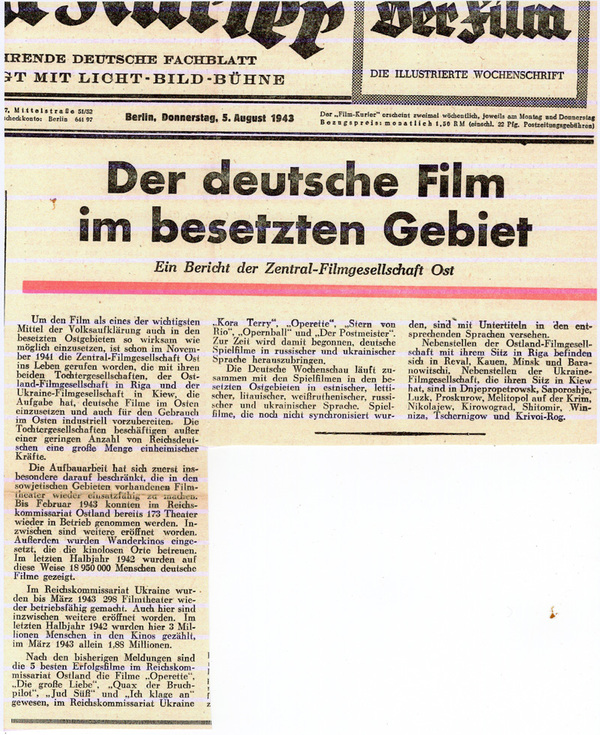
On the front page of the 25 February 1944 issue of the Film–Kurier Tageszeitung an article entitled 'Letter from Estonia' reported that 'in the two and one half years since the freeing of Estonians from the Bolshevik yoke, some 7.7 million cinema–goers have visited 49 movie theaters. It noted the popularity of German films distributed by Ostland Film GmbH, such as the Agfacolor films Die goldene Stadt, Immensee, Opfergang, and films such as Diesel, Maske im Blau, Germanin, Damals, and Kora Terry. Finally, the article noted that many cinemas as well as the projection equipment were destroyed or taken away by the retreating Red Army, and that the Bolsheviks had also taken away the trained projectionists. Many Estonian females were now graduating from a two and one half month training course as projectionists to fill this void.'
The national Film–Kurier Tageszeitung published five issues between November 1942 and February 1944 with front-page reports on the ZFO and Ostland Film and/or its subsidiaries Riga Film GmbH and Ukraine Film GmbH; and the William Gillespie Collection has all five original issues, shown below:
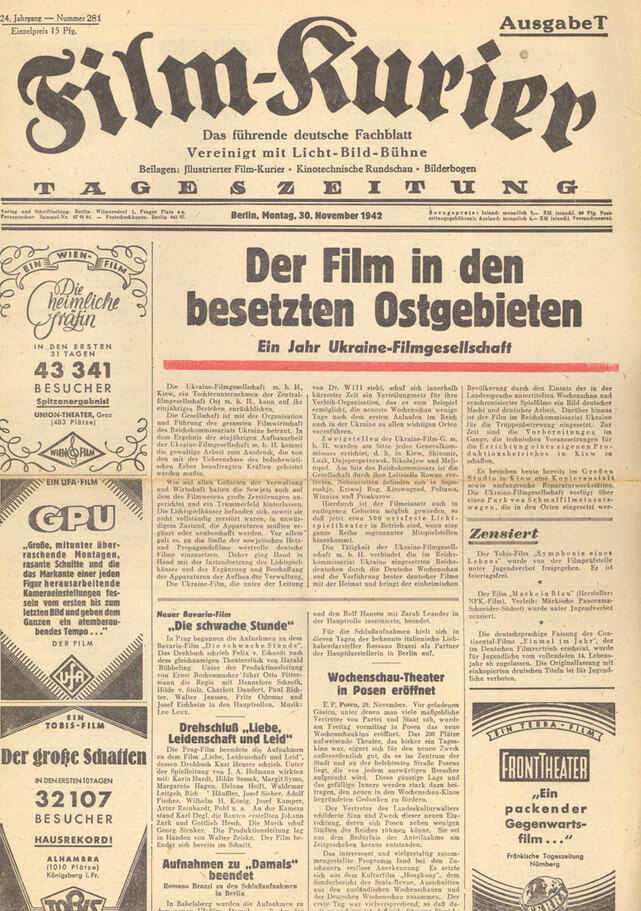
The front–page article above is translated here in English (©2020, German Films Dot Net, All Rights Reserved.)
from the FILM–KURIER TAGESZEITUNG. 30 November 1942
THE FILM IN THE OCCUPIED EASTERN TERRITORIES
One Year of the Ukraine–Film Company
The Ukraine Film Company, Kiev, a subsidiary of the Zentralfilmgesellschaft Ost, can look back at its first year of existence.
The Company is entrusted with the organization and leadership of the entire film industry of the Reich Commissioner Ukraine. The result of the reconstruction work expresses the tremendous work that had to be done by the forces entrusted with taking over the Bolshevik legacy.
As in all territories of administration and the economy, the Soviets caused great destruction to filmmaking and left behind a field of wreckage. The movie theaters were found, if not completely destroyed, in unworthy condition, equipment had to be added or newly procured.
Above everything else, it was important to replace Soviet hate and propaganda films with worthy German films. Hence this went hand in hand with the repair of cinemas and the complement and procurement of equipment by the Administration.
Ukraine Film GmbH, under the leadership of Dr. Will, created in the shortest time a distribution network for its film distribution organization, which for instance allows the latest newsreels to be presented in the most important locations in the Ukraine just a few days after they are shown in the Reich.
Branch offices of Ukraine Film were set up at the seat of each Commissioner General, that is in Kiev, Shitomir, Luzk, Dnjepropetrowsk, Nikolajew and Melitopol. At the seat of the Reich Commissioner the Control Centre in Rowno is represented. Adjunct branches are found in Saporoshje, Kriwoj Rog, Kirograd, Poliawa, Winnisa, and Proskurow.
This makes it possible to use films even in remote areas, so that today about 500 cinemas are operating, to which an entire series of other locations are added.
The activity of the Ukraine Film Company connects the Germans deployed in the Reich Commissariat Ukraine through the German newsreels with their homeland, and brings the local population through the use of native language subtitles for newsreels and dubbed feature films a picture of German power and German work. Furthermore, film in the Reich Commissariat Ukraine is used in supporting the troops. In progress is the preparation of the necessary technical requirements for the establishment of our own production facility in Kiev.
Today exists a great film studio in Kiev, a film copying lab institution as well as numerous repair workshops. Ukraine Film Company has a park of 16mm film type vehicles that are used in those places where normal 35mm film cannot be shown for technical reasons.
A convincing expression of this work already performed is a tour of the Small Studio in Kiev in the Administration Building of Ukraine Film. A rapidly growing entourage made up of Reich Germans and Ukrainian auxiliaries manages the rental activity. In the repair shops complicated precision mechanical work is carried out by trained workers and important spare parts for film equipment manufactured. The Technical Department is apparently independent of supplies from the Reich. It provides the cinemas in the Territory with everything they need.
Future prospects for filmmaking in the Ukraine is extraordinarily favorable. With the conquest of the Crimea, Germany has accrued an area with the best attributes for film. The Crimea contains all the landscapes required by film, and is characterized by its resistance to weather.
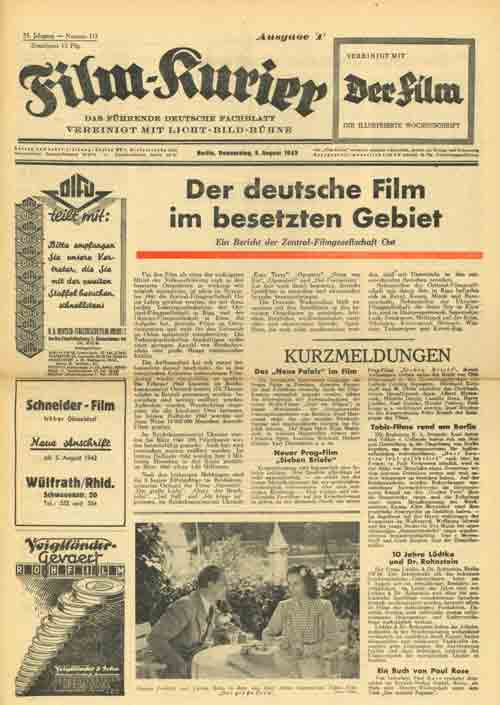
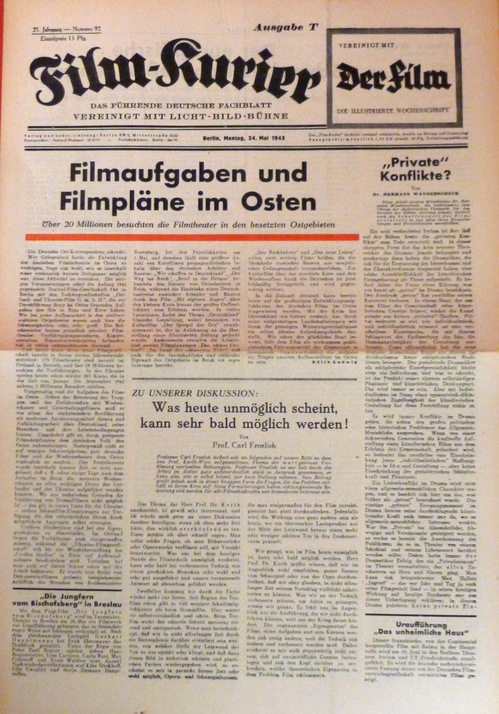
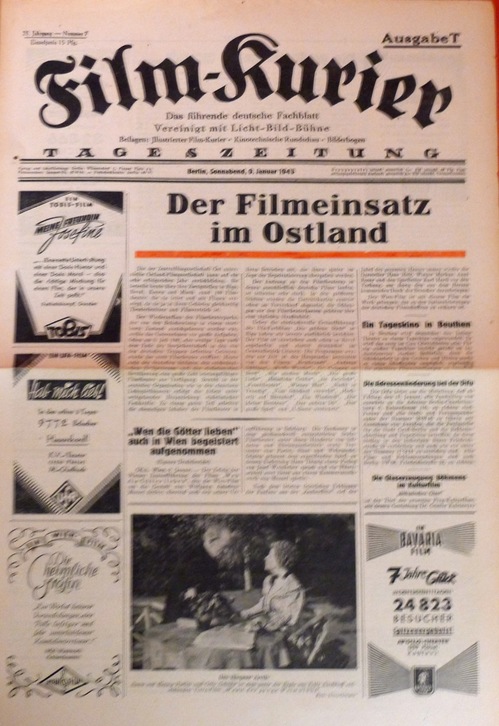

PRE-FABRICATED TIMBER-FRAMED CINEMA BUILDINGS FOR THE EASTERN TERRITORIES
The rapidly changing German military occupation of parts of the Soviet Union and Ukraine in 1943/44 made planning future ZFO activities difficult if not almost imaginery. Consider that nine full months after von Paulus had surrendered at Stalingrad, the Ufa Board of Directors in Berlin discussed the contract from the ZFO for the construction of two large wooden cinema theatres. Each was to be designed to hold 438 audience seats, and the price for each was set at RM220,000,- including transport. The Ufa Board was made aware that further cinema construction orders from ZFO were pending. (Ufa Vorstandsprotokoll Nr. 1546, 9.11.1943).
In February 1944, the Ufa Board again took up discussion about the two timber cinemas* for ZFO. One was to be entrusted with the Gauleiter of Westfalen–Sud and the other was to be stored temporarily in Schneidemühl, which is now in present–day Poland (Ufa Vorstandsprotokoll Nr. 1558, 17.2.1944).
* As further background on the use of pre–fabricated timber cinema buildings manufactured by ZFO, an article a few months after the Ufa Board meeting -- in the May 28, 1944 issue of the Deutsche Zeitung im Ostland -- reported on the introduction of such wooden structures:
" The newly opened movie theater is the first of the standard timber-frame cinemas that are being built in Ostland and contains 500 seats. The second cinema of the same type will be in Vilnius and is expected to be ready in June. More such cinemas are in preparation in Estonia. The beautiful [movie] house is in series production in Germany. The theater owns the newest German sound film playback apparatus and the most perfect technical facilities. Through a sensible installation of the radiator in the form of four tiled stoves in each corner of the auditorium makes it pleasant even in winter. "
In the October 1944 issue of the Swiss film journal Schweizer Film = Film Suisse, the official publication of Switzerland's Organization of Motion Picture Theaters in German/Italian Swiss lands, under news from various countries, under GERMANY appeared this short report:
The first standard wooden cinema built by the Central Film Company Ost together with Ostland Film GmbH. built, was opened in Vilnius. The individual parts of the house were mass-produced in Germany, transported to Vilnius and erected here on prepared foundations by local workers. It offers 500 seats. A cinema of the same design is planned for Minsk, and a third for Wilna and several of these series film theatres are to be opened in Estonia and used to show German films.
THE ALLIES WELL AWARE OF THE ZFO AND ITS SUBSIDIARIES
In the "Restricted" publication Propaganda in Occupied Europe (Army Service Forces Manual M356-2K, published by the U.S. Headquarters, Arms Servuice Forces, 9 February 1944) the ZFO, the Ostland Film GmbH, and the Ukraine Film GmbH are specifically mentioned and explained (pp.78–79) and the German propaganda network in the Eastern Occupied Territories is examined.
So by late 1943/early 1944 when this manual was written and published, the Americans were well aware of these film companies, and five months later, how they were to be handled after the German surrender was published in the following publication.
In the U.S. War Department "Civil Affairs Guide" published in July 1944, on how the Allies were to deal with German propaganda after the Third Reich was defeated, a list of Nazi officials who were to be arrested and detained included those of the "ZFO."
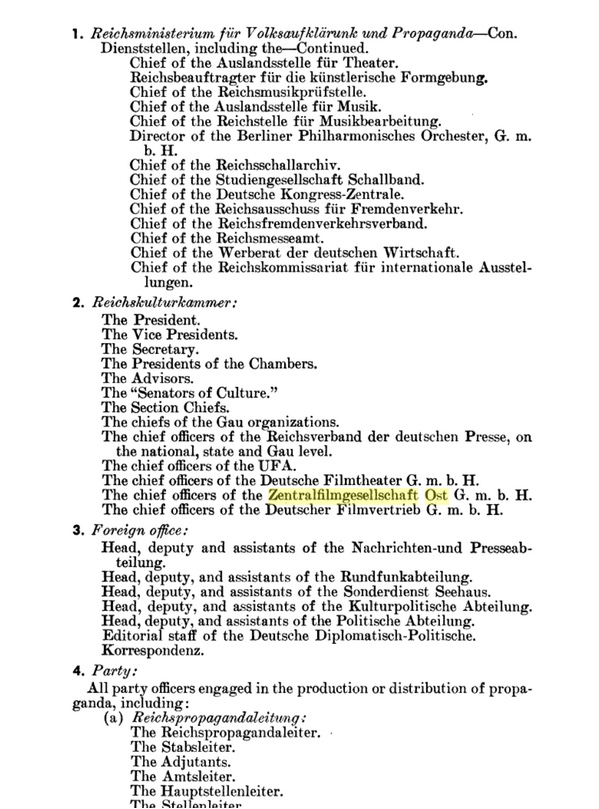
–––––––––––––––––––––––––––––––––––––––––––––
Dr. Erich Müller – Beckedorff
He was the Deputy Chairman of Tobis Filmkunst, one of the Third Reich’s top four film studios, and also the Head of the ZFO in the Occupied Eastern Territories from 1941 until the end of WWII.
Müller–Beckedorff enjoys no Wikipedia entry, no entry in Ernst Klee’s 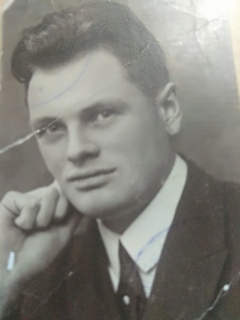 Das Kulturlexikon zum Dritten Reich, only a simple mention of him as a Board member of Tobis in the 318 page Die Tobis 1928–1945 CineGraph book, no mention in Dr. Goebbels’ diaries. Until 2022, we were unable to find a single photograph of him. His son, Peter Müller–Beckedorff, kindly contacted us via this website and provided the two photographs of his father which we have added to this biography. We are most grateful for his contribution.
Das Kulturlexikon zum Dritten Reich, only a simple mention of him as a Board member of Tobis in the 318 page Die Tobis 1928–1945 CineGraph book, no mention in Dr. Goebbels’ diaries. Until 2022, we were unable to find a single photograph of him. His son, Peter Müller–Beckedorff, kindly contacted us via this website and provided the two photographs of his father which we have added to this biography. We are most grateful for his contribution.
He came from a middle class family, born in 1 August 1902, and was a polyglot, having mastered French, English, Italian and Dutch as a young student. In 1928, he submitted his thesis to the University of Göttingen, entitled The shipping community in its importance under labor law.
He studied law at Columbia University in New York City and also in Geneva, and earned his law degree.
In 1932, he joined Tobis Film Syndikat as a young patent lawyer. Tobis held worldwide patent on the new invention of sound motion pictures, and had to defend these patents against aggressive competitors domestically, such as Siemens; as well as the Americans in RCA Victor and Western Electric. He soon became the Head of the Patent Department at Tobis.
He joined the prestigious artists club, the KDDK (Comradeship of German Artists) on December 16, 1936; so socialised with the elite of Third Reich cultural industries in film, theatre, dance, music, literature, and the visual arts, as well as leading members of commerce and industry. Both Dr. Joseph Goebbels and Reichsmarshall Hermann Göring held honorary KDDK memberships.
As Head of Tobis Patents, he had a responsibility to travel the world and both protect and enforce license agreements from Buenos Aires to San Francisco, and from Spain to Canada. In 1939 he was appointed to the Board of Directors of Tobis, and was exempt from military service due to his role in collecting Tobis license fees from foreign motion picture companies, earning the Third Reich large amounts in foreign currency. His memoirs mention him coming back to Germany with vast amounts of foreign currencies in his suitcases. Just prior to the German invasion of the Soviet Union in June 1941 – fo example – he was on an around-the-world trip which took him from Riga to Moscow, on the Trans-Siberian Express train to Siberia, on to Manchuria, Korea, Japan, Hawaii, San Francisco and Chicago, then New York City. Always picking up foreign currency. In Tokyo, he spent time with German Embassy staff member Richard Sorge, who later was exposed as a Soviet agent, and made a Hero of the Soviet Union for betraying Imperial Japan’s military secret to Stalin that Japan would not launch an attack from the East in tandem with the invasion of the USSR by German troops. (Thus allowing Stalin to shift hundreds of thousands of winter-trained Siberian troops to the German Eastern Front and eventually overwhelming them.)
On 8 February 1944 he was denounced to the Gestapo in Potsdam for having uttered “hostile comments against the Reich” by stating that its Racial Laws were “nonsense” and also the charge that he had smuggled provisions back to Germany on his trips. These charges were eventually dropped given his ability to generate significant sums of foreign currency when such funds were desperately required for the late war effort.
In late 1944, Tobis Filmkunst’s patent files and film inventory and material was transferred to Königshütte in the Harz Moutains, and secured in salt mines for protection against Allied bombing.
Müller–Beckedorff’s memoirs do not mention the words “Zentralfilmgesellschaft Ost,” or “ZFO” or “Ostland Film” or even the Eastern Occupied Territory “Reichkommissart Ostland” —not once. Even though his memoirs were not published until 1977, he obviously preferred to use the Tobis Filmkunst moniker to cover all his activities for the Eastern Occupied Territories film industry.
Nonetheless there are hints of his ZFO work in his book, in which he says:
Russians, Latvians, Estonians and Poles who were employed by Tobis had moved to the Harz Mountains with us….
When I saw the crowd of my trusted employees, it grabbed my heart ... There were still no borders between the occupation zones agreed by the victors. Death traps, as they were created later by the communist rulers, were still unknown ....
As Tobis boss I said goodbye to those who did not want to flee. All who did not leave or who no longer come away no longer live. As I later learned, they were convicted of treason or cooperation with the fascists and "liquidated", as the common word is.
––– Erich Müller–Beckedorff, Lange Leuchtet's Noch Zuruck, ein Lebensbericht, © 1977, Moorburg – Verlag Hannover.
He practiced as a lawyer in Hannover after ther war. He worked for the EWG (European Industry Association, forerunner to the EC) after the war. He was awarded the L'ordre national du Mérite from the Republic of France. He wrote his memoirs at age 73 in 1976. His son Peter confirmed that his father died on May 25, 1986 in Hannover.
©2021, German Films Dot Net
––––––––––––––––––––––––––––––––––––––––
Post–war note:
After the war, Latvia had an edge over Estonia and Lithuania in terms of feature film production, due to its inheritance of the infrastructure from Ostland Film GmbH, which had been established during the German wartime occupation for the production of films to be distributed throughout the region. Ostland Film was transformed under Soviet occupation into Latvias studio, but it would take several years before Lithuania and Estonia developed their own facilities.
Source: Davoliute, V., & Kaminskaite-Jancoriene, L. (2016). Sovietization and the cinema in the western borderlands: Insurgency, narrative, and identity in the lithuanian film maryte (1947) *.Jahrbücher Für Geschichte Osteuropas, 64(3), 391-408. Retrieved from https://www.proquest.com/scholarly-journals/sovietization-cinema-western-borderlands/docview/1822391388/se-2?accountid=34358 .
––––––––––––––––––––––––––––––––––––––––
Needless to say it is almost impossible to find original posters or material on these wartime efforts, which disappeared by about April 1944. We have in March 2020 acquired the Estate of a ZFO cameraman working in the Ukraine in 1942-1944. SEE our web page "What's new in 2020?" for details!
OUR TWO ORIGINAL OSTLAND FILM GMBH
cinema posters from Riga!
We have obtained two original Riga posters (note Ostland Film G.m.b.H. on the top of the poster for Das sündige Dorf, as well as the Riga cinema at the top of the Carl Peters poster, as well as the Wochenschau listings. These two posters are extraordinarily rare -- no other original copies are known to exist in national archives of any of the respective countries concerned, as at late 2014. In 2014 photos of our two posters were used by German film historian Dr. Ralf Forster at a seminar on German film production in the Occupied Soviet Union that was held in Moscow, at the Sergey Eisenstein Film School.
[ In his film Old and New, a/k/a The General Line, Eisenstein implicitedly endorsed Trotsky's planned extermination of the Ukrainian Kulaks – the killing off of anti–Semitic and class opponents of the new Soviet regime. This Holodomor was carried out by GPU Chief Yenokh Gershevich Iyeguda (born Jehuda) and Lazar Kaganovitch and 9-10 million, or 25% of the Ukrainian population was exterminated. ]
Larger images of these two posters can be found by clicking here: "Ostland Film" –– the posters are in the main Poster Gallery.
